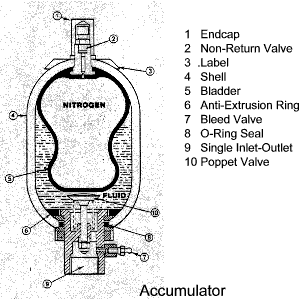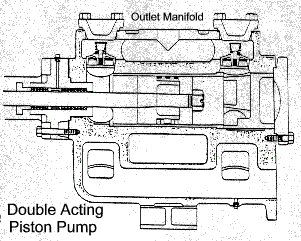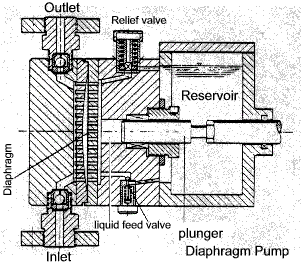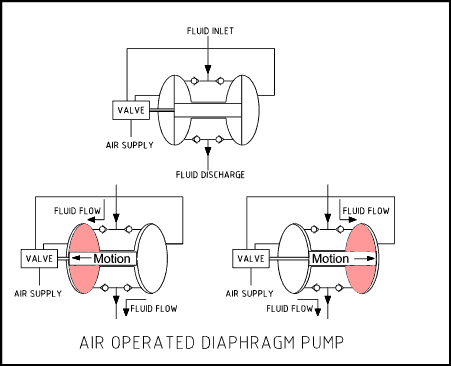Fluids Page
Back to Pumps Reciprocating Pump Notes
|
Reciprocating Pumps There are two general types of reciprocating pumps. The piston pump and the
diaphragm pump.
Piston Pumps /Plunger pumps A piston pump can be based on a single piston or, more likely, multiple parallel
pistons. The pistons are reciprocated using cams or crankshafts.
The stroke is generally adjustable. This type of pump can deliver heads of up to 1000 bar. The largest sizes of piston pumps can deliver
flows of 40m3 /hr. In practice these pumps are more likely to be used for
metering low flow rate fluids at more modest pressures in laboratories and chemical
process plants. Piston pumps are not generally suitable for transferring
toxic or explosive media.
Note: This description does not refer to the rotary piston pump as described in on the page on Rotary Positive Displacement Pumps...
Rotary Positive Displacement Pums There are two types of diaphragm pumps. The hydraulically operated
diaphragm metering pumps and the air actuated type. The hydraulically operated diaphragm metering pump is used for similar duties as the
piston pump. It has some significant advantages compared to the piston pump
in that the design does not require glands or piston seals The diaphragm in the
hydraulically operated diaphragm pump shown below is actuated using a plunger pump
arrangement. This provides full support of the diaphragm allowing high pressure operation.
The pump can include for duplex diaphragms with the interface being monitored
for failure of the diaphragm in contact with the fluid. This type of pump can
be used for pumping toxic and explosive fluids. The pump can deliver heads of
up to 700 bar and transfer flows of up 20 m 3 /hr. These pumps require
continuous monotoring as the diaphram is under high fatigue loading and the inlet and
outlet valves are subject to erosion and blocking. Under a high quality
maintenance regime these pumps are very reliable.
Air Operated Pump The air operated pump is generally a low cost work horse pump used for transferring
any type of liquid including sludge. The inlet and outlet valves are often low cost easily replaced
flap or ball valves. The pump is comprises two circular chambers each split by a large elastomeric
diaphagm. The two diaphragm centres are mechanically coupled together with a shaft.
An interlocked valve admits air pressure to one side of one of the chambers and exhaust the air from the opposite
side of the other chamber. This causes both diaphagms to move. One diaphragm
pushing fluid out through a non return valve. The other diaphragm drawing fluid in through a
non return valve. On completion of a full stroke the valve reverses the air supply and
exhaust directions causing the diaphragms to move back. The diaphragm which was
pushing fluid out of the pump now sucks fluid and the diaphragm admitting fluid now pushes
fluid out. The system is therefore double acting.
|
Links Providing information on Gaskets
Useful Links
|
|



